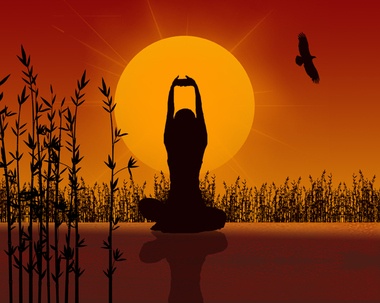Earlier, I talked about how you can use meditation practices “in real time,” while you’re working on a task, to stay focused and motivated. In this post, I’ll discuss how some forms of movement and breathing from yoga can help you find efficiency and ease in your work. Usually, when we think about productivity, images of well-organized e-mail inboxes and color-coded folders come to mind. But these things alone aren’t enough to make us efficient. If our minds aren’t disciplined — our attention is scattered, or we feel sluggish or anxious — work will be a struggle, no matter how organized our workspace is. How do we discipline our minds? I’ve found the ancient practice of hatha yoga — the stretches and breathing we simply call “yoga” in the West — very helpful. This may sound odd at first, but it makes sense if we look at why hatha yoga was created. It’s designed to clear the mind to prepare for meditation. In the same way, when we use it at work, it helps us become serene and focused. Although people tend to see yoga as a complex bunch of poses that require a mat and a lot of flexibility, there are simple forms of yogic breathing and movement we can do while seated. You can do the practices I’ll describe whenever you feel yourself losing attention or momentum at work.
1. Breathe Into The Tight Spot
When a student is in a yoga pose that’s bringing up a lot of discomfort, a yoga teacher will often tell the student to “breathe into” the uncomfortable spot in their body — meaning to breathe so that the tense part rises and falls with the breath. This helps the student relax into the pose. If you pay close enough attention when you’re feeling stressed or anxious at work, I suspect you’ll notice that some part of your body is tensed up — whether it’s your jaw, neck, lower back, or somewhere else. If you notice this, I invite you to try taking a few deep breaths into that tight place. When you do this, I think you’ll find the tension dissipating, and the stress starting to fade.
2. Open Up Your Shoulders
Many of us spend our workdays hunched over a keyboard, and this can cause tension to build in the neck and shoulders. When that tightness gets uncomfortable enough, it can disrupt our focus. Here’s a great way to release some of this tension — again, without leaving your chair. The pose I’ll describe is called “eagle arms.” To do this, hold your forearms out in front of you, parallel to your body. Cross your right arm in front of your left, and clasp your hands in front of your face so that your arms intertwine. Holding this pose, breathe deeply a few times into your shoulders. Repeat this with your left arm crossed over your right. I think you’ll find this helps you let go of the tightness in your shoulders, and return your attention to your work.
3. Breathe Into Your Heart
When we’re feeling unmotivated at work, it’s helpful to connect with our desire to contribute to and serve others. The yoga technique of breathing into your heart is a wonderful way to do this. According to yoga, there’s an energetic center in the heart area called the “heart chakra.” When we “open” the heart chakra by breathing into it, we feel our sense of compassion for others, and our desire to give to the world. To breathe into your heart, clasp your hands behind your back at the level of your heart, and stretch out your arms. Then, breathe deeply so your upper chest rises and falls with the breath. Feel the warmth and openness in your heart, and notice any tension melting away.
4. Breathe Into Your Spine
According to yoga, there’s another energetic center at the base of the spine called the “root chakra.” Breathing into the root chakra gives us a sense of groundedness and stability. Doing this can be very useful when you’re feeling anxious at work. To breathe into the root chakra, put your attention on the base of your spine, where the spine meets the pelvis. If focusing on that area is difficult, place your hand on your lower back, and concentrate on the sensation of pressure there. With your attention on the base of your spine, take a few deep breaths. When you do this, you’ll likely feel a deep-seated sense of solidity, and that paralyzing worry will start to fade.
